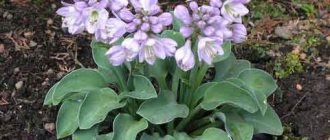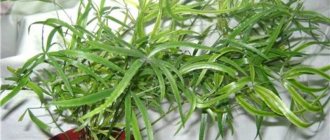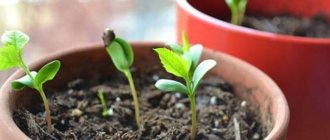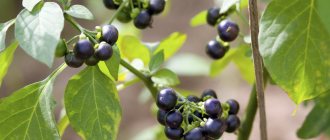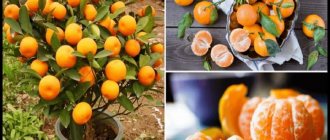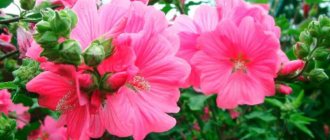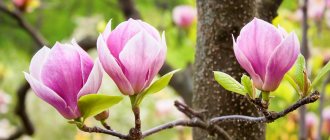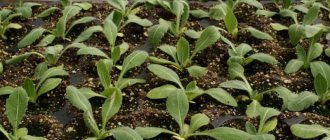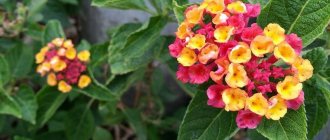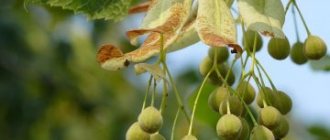Groups Growing exotic plants Vegetables
Enki April 17, 2020 at 3:08 pm 1759
Author: Enki
Log in to the site and you can join the group.
Good day!
I’ll tell you about a plant that is still considered exotic, but has the right to occupy a piece of our garden. This is luffa or loofah, I’ve seen it called both.
This plant is interesting for its fruits, which are useful in cooking and farming. For the middle zone and Siberia, most likely, only a greenhouse option with early planting is suitable, but for the south of Russia it is easy to grow in open ground.
Luffa is a herbaceous vine, somewhat similar in leaves and stem to cucumbers, only the fruits are very fibrous when ripe, due to which it has interesting properties. While the fruits are green, they can be eaten. And can be used as eco-scrubbers. I actively use them and now I’ll tell you how to make them.
So, if you need a soft washcloth for the body, then do not let the loofah ripen completely - pick it earlier and dry it under a canopy; the riper it is, the stiffer the fiber. If you need tougher ones, leave the fruits on the bush until they are completely ripe and yellow.
Ripe luffa looks like this:
To make a washcloth out of it, just soak it in boiling water and knead it. Like this:
The dry skin itself will begin to separate easily, exposing the fibers.
I peel it off completely, cut off the ends of the fruit and pour out the seeds. They will also be useful for sowing new loofahs.
We already have a washcloth preparation. I wash it well in soapy water and dry it.
What is luffa?
Luffa belongs to the pumpkin family and is considered to be native to Asia. Its appearance resembles a liana and can reach a length of up to 5 meters; thanks to these qualities, this plant is often used as a hedge.
Forms a weak root system that is located on the surface.
The fruits can reach a size of 70 centimeters. Depending on the degree of maturity, there are several ways to use them:
- Young fruits are widely used in cooking; they are prepared in the same way as zucchini. They have many useful qualities and are appreciated by lovers of tasty and healthy food.
- Mature specimens make an excellent luffa washcloth. This unusual use is due to the structure of the vegetable. When the fruit is fully ripe, it becomes strong, fibrous and reticulated.
Exotic culture with humor
Luffa belongs to the “royal” pumpkin family.
In its natural environment, it is found in African countries and sunny India. The culture is used in folk medicine in the treatment of:
- worms;
- anemia;
- dermatitis.
In addition, it is believed that young luffa fruits contain components that help strengthen the body's defenses. Those who get acquainted with the culture think that in front of them is an ordinary zucchini. After all, its fruits have a similar cylindrical shape. In a similar way, they are used to prepare salads, stews, or simply fry in a pan. However, the entire “essence” of the plant is hidden under a thick skin.
When luffa reaches full maturity, its flesh is pierced with so-called bunches. Around there are hard fibers that form a strong “skeleton” of the oblong fruit. Natural bath sponges are made from them. Therefore, growing luffa from seeds at home is of interest to many summer residents.
For cooking, only young fruits are used, which contain an abundance of calcium and phosphorus.
Wide alternate seven-fingered leaves grow on long liana-like shoots. Sometimes they are whole. During the flowering period, large yellow or white buds of a unisexual nature are formed on the crop. The staminate specimens are collected in racemose “bouquets,” while the pistillate specimens grow singly. After successful pollination, elongated fruits are formed on the shoots, which rapidly reach towards the sky. Hence the funny name “mad cucumber”.
Biologists count about 50 varieties of the plant. However, the most popular are:
- sharp-ribbed (grows up to 35 cm, cone-shaped fruit, dense pulp, used for cooking);
- cylindrical variety (maximum length about 70 cm, white flesh, used for the production of natural washcloths).
Despite its southern origin, the culture has wonderfully adapted to the middle latitudes. As a rule, it is cultivated in an open garden or in greenhouses. Let's find out what agronomists advise beginners who are ready to get to work.
Beneficial features
Loofah seeds contain a huge amount of edible oil and protein. Luffa is included in many cosmetic products.
There are also vegetable and technical varieties of this plant. They differ in the quality of the oil obtained and in the scope of its use. Technical varieties are used to prepare loofah, and the oil obtained from the seeds is included in various face masks and other cosmetics. Food grades are used in cooking.
Not only the fruits and seeds of the plant, but also their green part have beneficial properties. For example, the juice from luffa stems in Japan is widely used to create lipstick or used as a lotion to cleanse the skin.
Before World War II, luffa (loofah) was used for industrial production. Due to its light and porous texture, it was used in various filters and diesel parts.
Also, due to good sound insulation and high strength, the fruits of the plant were used as an inner layer in the manufacture of steel helmets and automotive equipment for the US Army.
Loofah - what is it, general description
The appearance of the fruit is very similar to a simple zucchini. Its interior has a porous structure, which is why the vegetable is nicknamed “porous squash.” About six dozen species of vegetables are described in nature. There are 2 varieties used in everyday life: sharp-ribbed and cylindrical.
Other types are small in size and lack the necessary characteristics.
But the loofah is valued for its large specimens, which have different purposes:
- young vegetables, picked slightly unripe, are used in cooking;
- Ripe or overripe ones are used to make washcloths and decorative items.
Types of luffa
One of the most specific representatives of the pumpkin family is the luffa. Many gardeners who are just starting to grow it on their plots want to know how to make a loofah from a plant. First you need to choose the right variety.
- Luffa sharp-ribbed - this subspecies of the plant is much easier to grow because it is less demanding on soil and care, and it is also less susceptible to various diseases. The flowers bloom at night, so they are pollinated by nocturnal insects or by hand. The fruits should be consumed before full ripeness, when their size is 30-40 centimeters, otherwise the taste of the product will change and be bitter. In its shape, luffa of this variety resembles a cone or club, the surface is ribbed, the skin is difficult to separate from the pulp.
The fruits are consumed in the same way as cucumbers. But at the same time they are included in curries and added to soups. The leaves, shoots and flowers of the plant are also edible; by simmering them for a few minutes and mixing them with oil, you can get an unusual and tasty side dish.
- Cylindrical luffa - this is the subspecies suitable for making loofahs. The length of the fruits can reach 70 centimeters, becoming slightly pointed towards the stalk. They are distinguished by thin skin, which is easy to separate, and delicate white pulp. According to the method of preparation, it is no different from sharp-ribbed luffa.
Collecting a loofah with a washcloth
Here you are: after over 4 months of struggling with your loofahs, it's time to harvest your juicy inner sponge! Here's how.
How can you tell if a loofah is ripe?
Some people will tell you to let the pumpkins fully ripen on the vine - you can do it that way, but I don't recommend it. If you let them mature too long, some of them will grow mold (no one warned me about this, so no problem).
When done, the squash will be dry and light, but not completely brown. A little green and yellow on the skin isn't a bad thing.
If you're still not sure if it's ready, feel the pumpkin. Is it lightweight? When you squeeze it, it should give a little - it's a sponge inside.
Just remember that they need to be harvested before the first frost strikes (this usually ends in late October for me in zone 7a).
Removing seeds and cleaning loofahs
Once you've collected your loofah and are ready to clean it, hit the pumpkin with something hard (like a countertop) to loosen the seeds.
Take the bottom part (the side that was not hanging on the vine) and cut it off.
Shake the loofah vigorously until the seeds fall from the bottom (you won't get them all out, but it will help).
Use scissors to cut the skin vertically and then peel the rest of the skin with your hands as if you were a banana.
Once you have removed all the seeds and peel, you will need to rinse the juice off the sponge. You'll have already noticed that the inside of the loofah is really slimy and quite rough - just wash it until it's no longer slimy.
The fastest way to do this is to use a garden hose and spray at a high level with a sponge until the slime disappears. But I find it especially difficult to hold a powerful hose in one hand and a slippery pumpkin in the other. So I prefer to just do it in the sink.
It takes longer, but I look less funny and my lips don't fly all over the yard.
Last Steps Before Using a Loofah
The color of the inner sponges ranges from white to dark brown, possibly even black, although this did not happen to me. If you're unhappy with the color of your sponge, you can soak it in a diluted bleach solution (one teaspoon of bleach per gallon of water) for a few minutes. I have never taken a bleaching bath because I don't like the idea of using a bleaching product on my skin.
Instead, if the sponge looks too unappealing, I wash it thoroughly with borax or castile soap until I'm satisfied. Baking soda and lemon juice or white vinegar will probably work just as well.
If the sponges still don't look good enough for you, just throw them in the "dirty jobs" pile and use them to scrub your floors or bathtubs. No need to throw them away!
Once you have thoroughly cleaned the sponges, all you need to do is dry them.
Place them in the sun on a towel for a day or so, or until they are completely dry.
Don't leave them wet or they will become moldy.
Now your hard-earned sponges are ready to cut and use! I love having a stash of homemade bath sponges, dishes, and sweet little gifts.
Growing seedlings
Many summer residents are wondering how to plant and grow luffa (loofah). The answer lies in the biological characteristics of this plant. It has a fairly long growing season, so the process usually begins with germination of seedlings.
- Since luffa seeds are very hard and covered with a thick shell, they need to be prepared for planting. To do this, about a week before work, they need to be placed in a very warm place, with an air temperature of at least 40 degrees.
- Then they need to be soaked in aloe juice for 20-30 minutes.
- You need to start growing seedlings in early April so that the fruits have time to ripen before the onset of winter cold.
- The soil must be nutritious and loose, in order to avoid the occurrence of bacterial diseases, it should be disinfected.
- The first shoots should appear 5-6 days after sowing.
- In order for the luffa (loofah) to receive as many nutrients as possible, when growing seedlings it needs to be watered twice with mullein diluted in water in a ratio of one to ten.
How and when to sow luffa
Since luffa is a heat-loving plant, in the middle zone it is most often grown in greenhouses in seedlings, and in regions with hot, long summers it can be grown in open ground. Given the long growing season (150-200 days, depending on the type and variety), seeds begin to be prepared for planting in the first ten days of March. First, they are heated for 7-10 days at a temperature of about 35°C, then soaked and kept in a damp cloth for several days at a temperature of 25-28°C.
Sow swollen or sprouted seeds into cups with nutritious soil to a depth of 15-20 mm, cover with glass and place in a warm place. As soon as the shoots appear, remove the glass and transfer the containers to a well-lit place where the temperature is 20-22°C. The seedlings are watered as the soil dries out, and 10 days before planting the seedlings in the ground, the plants are fed with complex organomineral fertilizer.
How to choose a place for a luffa?
Before planting a luffa, you need to choose the right place in which the plant will feel as comfortable as possible:
- Luffa (loofah) does not tolerate strong winds.
- Loves sunlight.
- The plant can be planted both in a greenhouse and in open ground.
- Before planting, you need to take care of the support; it must be strong and strong, because the plant grows very quickly and gains weight. An example would be a trellis, stretched twine, or even a metal mesh fence.
Planting and caring for luffa
- Planting: sowing seeds for seedlings - in early April, transplanting seedlings into open ground - in the second half of May.
- Lighting: bright sunlight.
- Soil: sandy loam or black soil.
- Watering: regular and plentiful (like cucumbers): the soil on the site should be slightly moist all the time.
- Feeding: once every 2 months with a solution of mullein with the addition of wood ash.
- Garter, pinching and shaping: from mid-June, excess ovaries should be removed, the lashes should be tied to a support, and the central shoot should be pinched at a height of 4 m.
- Reproduction: by seeds.
- Diseases: powdery mildew, anthracnose, brown and olive spot, root and white rot, bacteriosis, downy mildew, viral mosaic and bacterial wilt.
- Pests: plant is resistant.
- Properties: the plant is grown as a raw material for washcloths.
Read more about growing luffa below.
Transplantation into open ground
After the issue with the location has been resolved, it is necessary to plant the plants themselves. If the luffa is placed in a greenhouse, then the optimal time will be the second half of May, and if open ground is chosen as a permanent place of growth, then all work should be postponed until the beginning of June.
Before planting, you need to prepare holes, the depth and width of which will be 30 centimeters. The distance between plants should be at least one meter.
In order for the luffa (loofah) to take root as best as possible in a new place, the soil must be fertilized:
- You need to pour half a bucket of humus into the bottom and add 2 tablespoons of potassium sulfate there.
- Or you can use half a glass of ash per plant.
The luffa needs to be deepened to the cotyledon leaves, then the roots are carefully dug in; it is very important not to damage them during planting.
Plant care
Many people are interested in such a plant as luffa. How to make a washcloth? To make a bath accessory, you first need to grow high-quality fruits.
Luffa leaves absorb a huge amount of moisture, so you need to carefully ensure that the soil does not dry out and the plant has constant access to the necessary nutrients. Water for irrigation must be warm, otherwise the luffa may die. Experienced gardeners also recommend spraying the vine itself once every two weeks or using a sprinkler.
As soon as the first mature ovaries are formed, you need to select 3-5 of the strongest ones, the rest need to be plucked out. In order for nutrients to reach the fruit, it is better to remove the side branches, the same applies to excess green mass.
Luffa, like any other plant, requires a large amount of oxygen, so the soil needs to be loosened three times a season, given the shallow root system, this procedure must be carried out very carefully.
Pollination - initially only female flowers are formed, male flowers begin to appear only after 10-12 days. Given the nature of the plant, it is almost impossible to pollinate it with the help of insects; the most reliable way is to use the manual method. It will be possible to find out whether the work was carried out successfully or not in a few days; the pollinated ovaries increase significantly in size.
Caring for your luffa at home
Growing luffa from seeds
Growing luffa from seeds at home is not difficult, but before planting luffa, it is better to first hold the plant's hard seeds in a damp cloth until they swell and tiny white sprouts appear. This will take 1-2 weeks.
Tips from the pros for growing zucchini
- Cucumbers: why they turn yellow in the greenhouse and in the garden
Growing luffa seedlings is similar to growing cucumber seedlings. Fill the containers or pots with a moist nutrient substrate, carefully spread the hatched luffa seeds over its surface, cover them with a 3 cm thick layer of substrate, water, cover the containers with transparent film or glass and place in a warm place. Depending on the temperature in the room, seedlings will begin to appear in 1-2 weeks, and as soon as the first seeds germinate, the film can be removed from the crops.
In the photo: Growing luffa
The next stage of luffa development should take place at a temperature of 20˚C. How to grow luffa on a windowsill? Caring for seedlings involves regularly moistening and loosening the soil. In addition, seedlings need fresh air, so the room should be ventilated daily, avoiding the formation of drafts. At the development stage, seedlings have 5-6 true leaves; they are planted in open ground after a preliminary two-week hardening.
The first hardening session is carried out on a warm, clear day after 16:00: the seedlings are briefly taken out into the open air, protecting them from drafts, sharp gusts of wind and precipitation. Then the duration of daily walks is gradually increased to 5-6 hours.
Transplantation into open ground
Luffa requires significant space, and if you do not have a greenhouse, then it is better to plant hardened seedlings in open ground: adult plants will not fit on the windowsill. Seedlings are planted after hardening procedures at the stage of development of 5-6 leaves, provided that real spring has arrived and the air temperature in the garden is kept at 15˚C. This usually happens in the second half of May.
The site for the luffa has been prepared since the fall. The plant prefers open, sunny areas protected from wind and drafts with neutral, nutrient-rich soil. Chernozems and sandy loams are most suitable in this regard. Do not plant luffa where pumpkin or melon crops grew before, which require the same nutrients as luffa and suffer from the same diseases.
Dig up the area, clearing it of weeds and plant debris from the previous crop. In acidic soil, add cement dust, lime or dolomite flour for digging at the rate of 150-300 g per m². If the soil on the site is poor, two weeks after liming, dig it up with humus or compost at the rate of 1 bucket per m², and also add a tablespoon of potassium sulfate and urea and 2.5 tablespoons of superphosphate to each unit of area. Sandy soil requires more humus, and in too heavy soils, in addition to humus and mineral fertilizers, you will need to add river sand and deciduous soil.
- Vigna: a bean that might surprise you
For seedlings, holes are dug in the area with a depth and a diameter of 30 cm. The distance between the holes is maintained at least 1 m. A mixture of humus and compost is poured into the bottom of the planting hole, a seedling is placed on it and the remaining space is filled with soil. After planting, the area is watered.
Watering and fertilizing
Luffa loofah, like cucumbers, needs moisture, regular feeding, pinching, bush formation and strong support. Luffa is a lover of not only moist soil, but also moist air. It should be watered with a hose or sprinkler after 4 p.m. The frequency of watering and water consumption depend on weather conditions and soil characteristics: the soil in the garden bed should be slightly damp all the time, but not wet.
In the photo: Luffas drying
At first, the seedlings planted in the garden are watered once a week, but during the flowering period luffa requires more moisture.
Experienced gardeners recommend moistening the luffa three times a week from June to mid-September, and then gradually reduce watering. This moisture regime contributes to the rapid ripening of the plant’s fruits.
The root system of luffa is located superficially, so when watering you only need to wet a layer of soil 15-20 cm thick. After the water is absorbed, you should loosen the soil and remove weeds from the area.
Luffa is fed twice a month throughout the season. It is better to apply fertilizers to the soil in liquid form by dissolving 250 g of wood ash and 1 kg of mullein in 10 liters of water. The culture responds well to a solution of 1 part chicken manure in 10 parts water or 2 teaspoons of urea in a bucket of water.
Pinching, shaping and tying
The luffa plant requires constant attention: you need to ensure that the fruits are formed evenly, promptly remove unnecessary lateral shoots and pinch the central shoot at a height of 4 m. From mid-June, you need to remove excess ovaries that deplete the tops, leaving no more than 8 greens on the bush . The vines of the plant require regular gartering to a support so that the fruits do not become deformed or spoil: the fruit must hang freely from the trellis. Use your experience of gartering cucumber trellises.
- Laurel (Laurus) – care, photos, types
Pests and diseases
In unfavorable conditions and with poor care, luffa can be affected by diseases common to all pumpkin crops: powdery mildew, anthracnose, brown and olive spot, root and white rot, bacteriosis, downy mildew, viral mosaic and bacterial wilt. There are no drugs against bacterial and viral infections, and diseased plants should be immediately removed from the garden bed and burned. As for fungal diseases, the pathogenic microorganisms that cause them can be destroyed using solutions of fungicidal preparations that are used to treat luffa and the soil under the bushes.
Pests usually do not damage the luffa, but if such a problem occurs, treat the plant with an insecticidal preparation.
Fertilizing
You can fertilize the plant using the following substances:
- Ammonium nitrate is used during planting, second and third loosening.
- The mullein solution must be mixed with water in a ratio of 1 to 10. Fertilizing is done during the period of ovary formation.
- Complex fertilizer - you can use 1 tablespoon of nitrophoska diluted in a bucket of water. This procedure is carried out in the middle of the growing season.
- Superphosphate extract - 1 tablespoon of the substance is diluted in a bucket of water. This feeding promotes the ripening of seeds and the best ripening of the fruit.
When to collect luffa for sponging?
To use the fruits in cooking, they must be collected while they are young. But as for the manufacture of bath accessories, the time of removal will depend only on the desire of the person himself.
To get a soft loofah, you should collect green fruits, but for tougher specimens, mature, brown luffa is suitable. A prerequisite is to harvest the crop before frost, otherwise it will be unsuitable for use.
How to make a loofah from luffa?
Luffa is a loofah, the production of which begins with long-term drying of the fruit, usually lasting several weeks. To prepare the plant for the process, you need to trim the ends and get rid of the seeds. Then the future sponges are hung in a dry room, not allowing them to come into contact with each other, otherwise mechanical damage or wet spots may form, and the fruits will most likely rot.
The next step is soaking in boiling water. This procedure is necessary so that the skin of the fruit softens and is easier to remove.
As soon as the washcloth is almost ready, you need to clean its fibers from pulp and seeds with a stiff brush.
To prepare the sponge for use, you need to wash it in soapy water and dry it naturally by hanging it in a sunny area or placing it on a window.
When to Harvest
When favorable conditions are created for the plant, it can produce up to 12 large fruits. Fruits should be picked when night temperatures drop to +10 degrees. Unripe fruits are also removed; they are ripened at home, although drying takes a long time, up to several weeks. Moreover, it is necessary to dry the fruits in a suspended state, excluding their contact with each other.
To obtain the seeds, it is important to cut the fruit before the opening on the top of the head opens, before the luffa shoots. After full ripening, when the green color of the fruit changes to yellow and when shaken the fruit rattles like rattles, the peel is removed.
To make peeling easier, soak the luffa in boiling water for a few minutes and remove the skin when it becomes soft and pliable. The inside of the fruit is cleared of remaining pulp and seeds. Wash the sponge in soapy water and dry well.
How to sew a washcloth
Since the prepared sponge is long, for convenience it should be cut into several parts and handles tied to the edges.
For strength, the washcloth can be given an oval shape by cutting it with scissors and sheathing it around the entire oval with fabric, first attaching loops at both ends. The correct treatment of the washcloth with a cloth is determined in a simple way. It should not stretch in hot water, and should not shrink in cold water.
Where to buy a washcloth
You can buy a washcloth in the Zdoroveevo online store. Click on the banner and go to the store:
How to use a natural loofah
The porous structure of the luffa fruit itself is very hard, to soften it a little, keep it in hot water for 2 minutes. Reviews about natural sponge made from vine fruits are only positive. The washcloth exfoliates old dead skin cells well and does not cause irritation.
But an organic washcloth will quickly become colonized by pathogenic microbes if you do not keep it clean. After each water procedure, you need to wash the washcloth with soap and dry it well, and then it will last you up to 6 months.
As you can see, luffa is a very versatile plant, but its most important property lies in its healing properties that provide health benefits.
I wish you health and longevity!
How to sew luffa washcloths?
To make the bath accessory convenient to use, it is cut to the required size and the handles are attached. You can also design the washcloth in the form of a scraper. To do this, the luffa is given an oval shape, one side is completely covered with fabric, to which a loop is attached in advance.
If the washcloth does not stretch in hot water and does not shrink in cold water, it means that the entire technology was performed correctly.
Luffa what is it, botanical description
The herbaceous luffa vine belongs to the Cucurbitaceae family, so it can easily be confused with squash or pumpkin, but upon closer examination they have many differences. The main one is the porous structure of the fruit pulp.
Its homeland is the tropical hot countries of Asia and India, Oceania and Africa. The genus of this vine of the same name has up to 50 different species. Now the area of its cultivation has expanded; it is cultivated in China, the Caribbean, and the Philippines.
In Russia, the tropical liana grows well in the Crimea and the southern Caucasus. And if favorable conditions are created for the plant, then it can be grown in central Russia.
Types of tropical vines used for technical purposes
Of all the variety of herbaceous vines, only two species stand out that have received popular recognition: Egyptian or cylindrical luffa (Luffa cylindrica) and sharp-ribbed luffa (Luffa acutangula). Below see photos of vines. All other types have small fruits and are therefore not suitable for use.
Luffa cylindrical , like all other representatives of this genus, grows wild only in subtropical conditions. The liana is an annual, propagated by seeds, the length of the stem sometimes reaches 6 meters. The stem has 5 rough ribs, from which strong tendrils grow with three branches, clinging to the support.
Large leaves, up to 25 cm in circumference, have long petioles up to 12 cm, the leaf blade is serrate-five-lobed.
The plant has dioecious flowers with bright petals, bright yellow. Male flowers (staminate flowers) grow in clusters of 16-20 flowers. And the female (pistillate) ones are solitary, located next to the staminate ones, in the axils of the same leaf.
From the female flowers, a fruit develops that has a cylindrical or club-shaped shape, which can grow up to 50 cm long. It has a smooth shape, inside which numerous flattened and smooth seeds with a marginal border ripen.
Luffa sharp-ribbed or faceted grows wild only in Pakistan and India. But now it has been naturalized in all countries with tropical and subtropical climates.
The description of the plant is the same as the cylindrical luffa. The stems and leaves grow the same way and are almost identical in description. Flowers open only at night and are pollinated by nocturnal insects. This type of vine is less capricious to grow and more resistant to infection by fungal diseases.
But the fruit is different. It grows up to 30-40 centimeters in length and up to 10 cm in diameter, and has a cone-shaped shape. Its surface is covered with protruding ribs.
The pulp of a young fruit is soft and juicy, slightly sweet, reminiscent of the taste of a cucumber. As the fruit grows and ripens, it becomes riddled with hard fibers and becomes completely dry. And after the fruit dries, the internal contents of the fruit resemble a fibrous sponge, consisting of intertwined bundles of conductive tissue. The skin adheres very tightly to the fibers and can be separated only after soaking in hot water.
In the middle of the sponge there are flattened, wrinkled seeds up to 1 cm long, black in color. During the period of full ripening, a hole is formed at the top of the fruit and the fruit “shoots out” the seeds along with the accumulated mucus. Therefore, plants belonging to this genus are popularly called “mad cucumbers.”
How to use a luffa sponge?
Before using such a sponge, you need to soften it a little by holding it in hot water for 2-3 minutes.
Luffa is a washcloth, reviews of which always remain at the highest level. But in order not to harm your body, but to bring a beneficial effect, you should not overdo it in use (no more than twice a week). Otherwise, irritation may appear on the body or skin breakdown may occur.
After each use of such a washcloth, you must use moisturizing creams or oils.
Luffa has the ability to remove dead skin cells, but after a month of use, the pores of the sponge become clogged and bacteria begin to multiply in them.
After each use, the washcloth must be thoroughly rinsed and dried.
Luffa or edible natural loofah
10/30/2020 Luffa ( lat. Luffa
) is a genus of herbaceous vines of the Cucurbitaceae family. Currently, its representatives can be found not only in the tropics and subtropics, but also in the garden plots of our domestic gardeners.
In total, there are more than 50 species of this plant in nature, but in culture two of them are most widespread and popular:
Luffa cylindrical or Egyptian (lat. Luffa cylindrica)
This plant prefers warm and humid climates and is therefore cultivated in tropical countries in Asia, Africa and the United States.
The unripe fruits of the cylindrical luffa are edible and very healthy. For example, they contain one and a half times more carotene than bell peppers and carrots. The fruits are mainly used for preparing first courses and curries. The plant's flower buds, young shoots and leaves are also considered edible, and are mainly used for preparing various side dishes.
Fully ripened fruits are not eaten, because as they ripen they gradually acquire a bitter taste, and the internal fibrous tissue becomes very coarse.
Luffa acutangula (lat. Luffa acutangula)
The culture is widespread in the Caribbean, as well as in India, Indonesia, Vietnam, Malaysia and the Philippines.
The fruits of the sharp-ribbed luffa are medium-sized (about 30–35 cm in length); they are also eaten unripe, like cucumbers.
Other representatives of the genus are not currently cultivated due to their too small fruits.
The growing season of luffa is quite long, but this plant is not demanding on growing conditions and is practically not susceptible to fungal infections.
Description
The luffa stem is branched and can reach 5–7 meters in length. With the help of branched rough tendrils, the vine clings to obstacles, tending upward, so it is planted near fences and fences, or high supports are purposefully installed nearby.
The leaves of the plant are long-petiolate, dark green in color, and have 5–7 lobes. Their shape is heart-shaped, and their size ranges from 14 to 25 cm in diameter. The edges of the leaf blade are edged with denticles.
Luffa blooms with large yellow flowers. The male ones are collected in racemose inflorescences, the female ones are solitary.
The fruits externally resemble an overgrown zucchini, pale green in color. They are ribbed, have a club-shaped cylindrical shape and can reach more than 50 cm in length.
The seeds resemble watermelon seeds and are black or whitish in color.
Use of the plant
As they ripen, a dense and durable fibrous tissue is formed inside the luffa fruit, which in its structure resembles a sponge, and therefore has long been used to make bath sponges. For the first time, the natural properties of luffa began to be used by Portuguese sailors, who adapted the contents of the fruit for washing and massaging the body.
Currently, this plant is purposefully grown to produce natural washcloths on an industrial scale.
In order to make a loofah, the luffa fruits must first be allowed to ripen and dry thoroughly. Next, they are soaked in water for a long time, after which the peel is removed (this requires some effort), and then the seeds are shaken out. The contents of the fruit are washed, dried and cut into pieces of the required size. The washcloth is ready.
Luffa can be used as a natural filter for water purification to trap large particles of debris. And since this material also has high heat-insulating, noise-absorbing and shockproof characteristics, it is used as a sealant for various devices and mechanisms, as well as in the production of natural shoe pads.
Growing a plant
Most often, luffa is grown by seedlings, since this crop has a fairly long growing season, but if climatic conditions permit, the seeds can be sown in open ground. In any case, the seedling method makes it possible to get an earlier and more generous harvest.
Seeds are usually sown in April. For this purpose, it is better to use special peat pots about 7 cm in diameter, since luffa does not really like transplanting. The soil substrate should be well fertilized and moderately moist.
Since luffa seeds are quite hard and have a thick shell, it is advisable to warm them up for a week at a temperature of +40°C immediately before planting.
They are buried to a depth of about 2 cm. After this, the soil is lightly watered and covered with plastic film, which will help create a special microclimate.
Before the first shoots appear, the temperature in the room where the containers with future seedlings are installed should be about +30°C. After about a week, in some cases a little later, sprouts will appear, and as soon as this happens, the air temperature should be reduced to +20°C. The film must be removed from the plants.
In early May, as soon as the night temperature exceeds +15°C, pre-hardened seedlings can be planted in open ground.
A few days before planting, it is advisable to fertilize the seedlings with liquid mullein (at a rate of 1:10).
Luffa prefers loose and well-fertilized light soils. It is recommended to pre-apply about 5 kg of humus, 20 g of potassium sulfate, 50 g of superphosphate and 40 g of ammonium nitrate per square meter of area. Nitrate should be applied in three doses: at the time of plant picking, and also immediately after the second and third loosening of the soil.
The planting site must be reliably protected from drafts and wind, since the vine is highly sensitive to cold.
Seedlings are planted in pre-prepared holes measuring 30x30 cm and up to 20 cm deep. The distance between individual specimens should be about 1 m, and the distance between rows should be at least 1.5 m.
As soon as the plants throw out their “whiskers”, which usually happens after the formation of 5-6 true leaves, it is necessary to install reliable and high supports for the vines, which will serve to guide and support the growing stems. If this is not done, they will begin to creep straight along the ground, as a result of which the fruits may become deformed.
Since luffa consumes a large amount of nutrients as it grows and develops, it is advisable to feed it at least twice a month with a solution of mullein, to which a glass of wood ash should be added.
We must not forget about watering the plants abundantly, since the large leaves of the luffa evaporate a fairly large amount of moisture. Watering should be done very carefully so as not to damage the root system, since the root of the vine is relatively weak and located close to the surface of the earth.
To shorten the growing season of luffa, it is advisable to pinch the main stem at a distance of 3 m from the base of the plant. It is equally important to promptly remove all distorted and underdeveloped fruits. And to make them larger, you can artificially limit the number of ovaries to 5–6 pieces.
Have a good harvest!
Use of luffa in medicine
Many countries in Asia and the East widely use luffa in folk medicine. A decoction of the roots and green parts of the plant is an excellent remedy for stopping internal bleeding; it is also used to treat sinuses.
Many cosmetologists recommend using luffa with homemade soap. Melted soap is poured into the holes that form after peeling the fruit from seeds and pulp and the resulting sponge is used as a scrub. This cosmetic product will perfectly cleanse the skin and stimulate blood circulation in small vessels.
One of the most beneficial fruits for the skin comes from a plant called luffa. The washcloth, the photo of which can be seen above, is an environmentally friendly product. With enough effort, you can grow it in your garden. In addition, the vines on which the fruits are formed have an unusual appearance, so they are often used in landscape design.
Application of luffa
The pulp of young green luffa plants is used for food. It is especially widely used in Asian cuisine: fried, stewed, baked, eaten raw. To prepare dishes, you need fruits with soft and uniform pulp, the length of which does not exceed 15 cm. Luffa seeds can be cracked like sunflower seeds by roasting them in a dry frying pan.
The dried insides of ripe fruits are used to produce washcloths, filters, rugs, natural fillings for mattresses, vases, lampshades, screens, flower pots, hats and other products. In order to make a washcloth, you need to remove seeds and peel from the fruit. However, keep in mind that pathogenic microorganisms quickly multiply in organic material from moisture, so after washing the washcloth must be thoroughly washed and dried. The shelf life of a luffa washcloth with proper care is no more than 3 months.
Luffa juice can cure conjunctivitis and nasopharyngeal diseases. Luffa has a tonic, immunostimulating and antipyretic effect. Luffa bandages are an excellent replacement for plaster: they are light, strong, reliably fix the position of the limb and stimulate blood circulation. Luffa is also in demand in the cosmetic and pharmaceutical industries.
